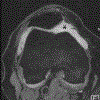MRI-based screening for structural definition of eligibility in clinical DMOAD trials: Rapid OsteoArthritis MRI Eligibility Score (ROAMES)
- PMID: 31513920
- PMCID: PMC7235947
- DOI: 10.1016/j.joca.2019.08.005
MRI-based screening for structural definition of eligibility in clinical DMOAD trials: Rapid OsteoArthritis MRI Eligibility Score (ROAMES)
Abstract
Purpose: Our aim was to introduce a simplified MRI instrument, Rapid OsteoArthritis MRI Eligibility Score (ROAMES), for defining structural eligibility of patients for inclusion in disease-modifying osteoarthritis drug trials using a tri-compartmental anatomic approach that enables stratification of knees into different structural phenotypes and includes diagnoses of exclusion. We also aimed to define overlap between phenotypes and determine reliability.
Methods: 50 knees from the Foundation for National Institutes of Health Osteoarthritis Biomarkers study, a nested case-control study within the Osteoarthritis Initiative, were selected within pre-defined definitions of phenotypes as either inflammatory, subchondral bone, meniscus/cartilage, atrophic or hypertrophic. A focused scoring instrument was developed covering cartilage, meniscal damage, inflammation and osteophytes. Diagnoses of exclusion were meniscal root tears, osteonecrosis, subchondral insufficiency fracture, tumors, malignant marrow infiltration and acute traumatic changes. Reliability was determined using weighted kappa statistics. Descriptive statistics were used for determining concordance between the a priori phenotypic definition and ROAMES and overlap between phenotypes.
Results: ROAMES identified 43 of 50 (86%) pre-defined phenotypes correctly. Of the 50 participants, 27 (54%) had no additional phenotypes other than the pre-defined phenotype. 18 (36%) had one and 5 (10%) had two additional phenotypes. None had three or four additional phenotypes. All features of ROAMES showed almost perfect agreement. One case with osteonecrosis and one with a tumor were detected.
Conclusions: ROAMES is able to screen and stratify potentially eligible knees into different structural phenotypes and record relevant diagnoses of exclusion. Reliability of the instrument showed almost perfect agreement.
Keywords: Clinical trial; Eligibility; MRI; Osteoarthritis.
Copyright © 2019 Osteoarthritis Research Society International. Published by Elsevier Ltd. All rights reserved.
Conflict of interest statement
Conflict of interests
FWR is shareholder of Boston Imaging Core Lab. (BICL),LLC.
CKK is consultant to EMD Serono, Thusane, Express Scripts, Regulus, GSK, Regeneron, Fidia, Taiwan Liposome Company.
TN is consultant to Pfizer, EMD Merck Serono, Novartis.
DJH is consultant to Merck Serono, Pfizer, Tissuegene, TLCBio.
MH received an institutional grant by the NIH and is consultant to EMD Serono.
JEC is consultant to Boston Imaging Core Lab (BICL),LLC.
AG has received consultancies, speaking fees, and/or honoraria from Sanofi-Aventis, Merck Serono, and TissuGene and is President and shareholder of Boston Imaging Core Lab (BICL), LLC a company providing image assessment services.
DTF and JL have no conflict to declare.
Figures





















References
-
- Hunter DJ, Schofield D, Callander E. The individual and socioeconomic impact of osteoarthritis. Nat Rev Rheumatol 2014;10:437–41. - PubMed
-
- Karsdal MA, Byrjalsen I, Henriksen K, Riis BJ, Lau EM, Arnold M, et al. The effect of oral salmon calcitonin delivered with 5-CNAC on bone and cartilage degradation in osteoarthritic patients: a 14-day randomized study. Osteoarthritis Cartilage 2010;18:150–9. - PubMed
-
- Alexandersen P, Karsdal MA, Byrjalsen I, Christiansen C. Strontium ranelate effect in postmenopausal women with different clinical levels of osteoarthritis. Climacteric 2011;14:236–43. - PubMed
Publication types
MeSH terms
Grants and funding
LinkOut - more resources
Full Text Sources
Other Literature Sources
Medical

